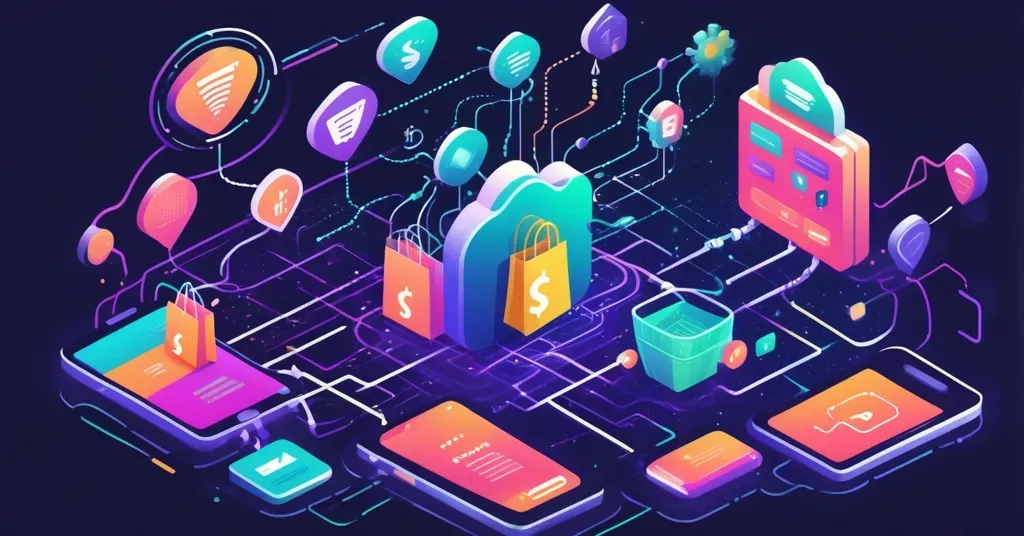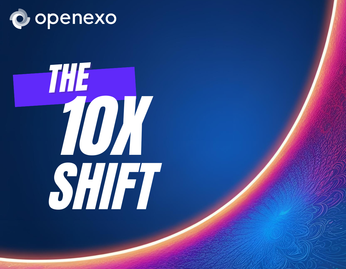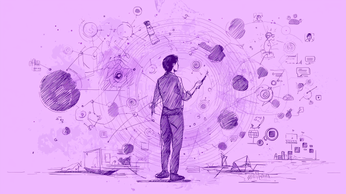
Global Intelligence: Managing Key Shifts in Five Steps
Generative AI aids strategic intelligence by transforming data into insights. The Global 50 report highlights trends like internet growth and tech adoption. Businesses must recognize shifts, act on insights, and adapt to gain a competitive edge in a fast-changing world.
Quite literally all of the world’s information is at our fingertips. Generative AI provides access to vast data, summarised insights, and pattern recognition at scale. Reports published by organisations around the world, ranging from the IMF, World Bank, and OECD to Dubai Future Foundation, ARK Invest, and the World Economic Forum, provide insights on economic shifts, industry trends, and emerging risks. And, corporate research from firms like PwC and McKinsey, alongside open datasets from global institutions, offer valuable commercial intelligence.
Yet, while the information is available, its value lies in developing strategic intelligence that supports smarter business success - what edges us closer to investment, income, influence, and introductions that result in commercial outcomes.
Here, we explore how to do this in a resource light way.
The Global 50: Identifying Accelerating Trends
We start with the Dubai Future Foundation’s The Global 50 report published by the Dubai Future Foundation and endorsed by His Excellency Mohammad bin Abdullah Al Gergawi, UAE Minister of Cabinet Affairs and Chairman of the Dubai Future Foundation.
Leaders frequently hear about rapid change, yet what does this mean in practical terms? More importantly, how do we determine which shifts are accelerating and could provide a competitive edge in business?
The report highlights several key areas experiencing significant acceleration:
- Internet Penetration: In 2014, 2.8 billion people (under 40% of the world’s population) had internet access. By 2024, this had surged to 5.5 billion (two-thirds of the global population).
- Explosion of Data: In 2014, the world generated 12.5 zettabytes of data (equivalent to 3.1 trillion DVDs). By 2024, this had grown 11x to 147 zettabytes.
- Technology Adoption Speed: Slack took six months to reach 500,000 users in 2014. In contrast, ChatGPT reached 100 million users in the same timeframe after launching in 2022.
- Patent Registrations: In the first decade after the US patent office was established (1790–1800), 229 patents were registered. By 2015, this was the daily average. In 2023, the same number of patents were registered every two hours.

Recognizing these accelerating trends is the first step. The next challenge is translating them into actionable business intelligence.
Key Shifts from The Global 50 Report
The Global 50 report categorises emerging shifts into five key areas that are shaping industries, economies, and societies. Each represents a transformation in how the world operates and offers strategic opportunities for those who can act early.
Health Reimagined
Medical advancements are redefining healthcare. Precision medicine, AI-driven diagnostics, and regenerative therapies are making healthcare more personalised and effective. Longevity science and bioengineering are pushing human lifespan expectations, while breakthroughs in telemedicine are expanding access to healthcare globally.
Nature Restored
Sustainability is moving beyond policy discussions to become an operational priority. Innovations in carbon capture, circular economies, and alternative proteins are reshaping industries. Regenerative agriculture and green hydrogen technologies are accelerating efforts to combat climate change, creating both risks and opportunities for businesses adapting to a low-carbon economy.
Societies Empowered
The rise of decentralised technologies, new governance models, and digital identities is giving individuals more control over their data, finances, and decision-making power. Financial inclusion is expanding through digital banking and mobile payments, while AI-driven education platforms are democratising access to knowledge.
Systems Optimised
Automation, AI, and blockchain are making industries leaner, faster, and more efficient. Smart cities, autonomous supply chains, and intelligent energy grids are reducing inefficiencies and enabling a more connected world. Businesses that leverage real-time data and algorithmic decision-making are gaining a strategic edge.
Transformational
Some shifts fundamentally alter how the world functions. Quantum computing, space economy expansion, and bio-digital convergence are opening entirely new markets. These transformations require businesses to rethink long-term strategies and prepare for disruptions that may upend industries as we know them.
Recognizing these shifts is the beginning. The next step is converting these insights into competitive advantage.
Why Strategic Intelligence Matters
Access to information alone is not a competitive advantage. The sheer volume of data and speed of technological change mean that businesses must develop the ability to filter, interpret, and act on insights with precision. The organizations that achieve sustained commerical success will be those that move from passive awareness to proactive intelligence - leveraging the right data, challenging assumptions, and acting before existing and emerging competitors do.
This is less about predicting the future with certainty and more about increasing the probability of making better decisions in a world of uncertainty. Those who can identify blind spots, validate insights with key connections, and adjust in real time will be better positioned to secure investment, open new revenue streams, and influence the markets they operate in.
Strategic Intelligence Framework for Actionable Insights
This framework provides a structured approach to converting raw information into strategic advantage. It consists of five key steps:
- Identifying blind spots and biases
- Mapping shifts before they materialise
- Validating insights through expert networks
- Prioritizing actions that drive commercial outcomes
- Continuously iterating based on real-time developments
Rather than relying solely on historical data or intuition, this approach leverages real-world signals, expert perspectives, and practical experimentation to ensure leaders stay ahead of accelerating change. It serves as a tool to move from insight to impact, transforming knowledge into competitive advantage.
Applying the Strategic Intelligence Framework to The Global 50
1. Identify Blind Spots & Biases (Recognizing What You’re Missing)
Why it matters:
Shifts are accelerating, making outdated assumptions a liability. Leaders must actively challenge entrenched views and surface hidden risks or opportunities.
How to apply it:
- Compare current strategic assumptions against the megatrends and emerging opportunities in The Global 50.
- Identify what is missing from your current worldview.
- Challenge existing beliefs that may no longer hold true in an accelerating landscape.
Action:
- Known unknowns: Where do intelligence gaps exist?
- Unknown unknowns: What disruptions could emerge unexpectedly?
- Cognitive biases: Which long-held assumptions need to be questioned?
2. Map Strategic Shifts (Anticipate Change Before It Happens)
Why it matters:
The pace of disruption is increasing, and organisations that react too late risk being outpaced by competitors and emerging market shifts.
How to apply it:
- Use scenario planning to evaluate potential futures based on The Global 50’s insights.
- Assess the short-, medium-, and long-term impact of these shifts.
Action:
- Categorise each insight into:
- Opportunities to act on now
- Risks that require mitigation
- Uncertainties that need monitoring
3. Validate & Fill Gaps with Key Human Connections (Turn Data into Smarter Decisions)
Why it matters:
Data alone does not lead to action - insights must be tested, challenged, and validated by industry leaders, investors, and experts.
How to apply it:
- Identify who is already acting on these insights and what can be learned from their approach.
- Consult experts from different industries, geographies, and regulatory backgrounds to pressure-test assumptions.
Action:
- Engage a network of decision-makers across industries and regions.
- Seek alternative viewpoints from policymakers, academics, and risk analysts.
- Form a rotating advisory board to continuously challenge and validate insights.
4. Prioritise & Take Measured Action (Convert Insights into Competitive Leverage)
Why it matters:
Insights without execution do not create advantage. Leaders must prioritize the right actions at the right time.
How to apply it:
- Categorize insights based on their impact on investment, income, influence, or introductions.
- Identify low-risk, high-impact opportunities to test before scaling.
Action:
- Investment - Which shifts could unlock capital or funding opportunities?
- Income – Which create new revenue streams or business models?
- Influence – Which position you as an authority in emerging trends?
- Introductions – Which insights can help build global relationships?
5. Monitor & Iterate in Real-Time (Keep Adapting as Conditions Change)
Why it matters:
The speed of change means that strategies must be continuously refined - static approaches become obsolete.
How to apply it:
- Establish a quarterly review cycle to reassess assumptions and update insights.
- Track real-time indicators that signal accelerating or slowing trends.
Action:
- Review new signals and emerging shifts every quarter.
- Adjust strategies and investments accordingly.
- Maintain a feedback loop with advisory networks and industry experts.
From Insight to Advantage
The challenge for business leaders isn’t access to information, rather it’s the ability to transform raw insights into strategic intelligence that enables action. By identifying blind spots, tracking key shifts, validating insights through human networks, and systematically acting on intelligence, leaders can move beyond passive awareness to proactive decision-making.
We often hear how the world is shifting faster than ever. With the world's information at our fingertips, it's acting proactively on the most critical shifts that drive sustained commerical success.
ExO Insight Newsletter
Join the newsletter to receive the latest updates in your inbox.








